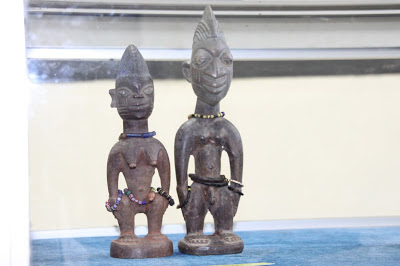Unearthing a legacy
"People from different parts of the world can respond to the same story if it says something to them about their own history and their own experience," said Nigerian author Chinua Achebe. A small fable from his homeland is being etched in a section of the African Caribbean Institute of Jamaica in downtown Kingston.
It's a story of the African nation's rich history, the artefacts reminiscent of the tribal rituals, prehistoric caricatures, culture and usage.
"Jamaica has inherited a lot from other cultures, particularly the African culture," said Maxine Watson, librarian at the African Caribbean Institute of Jamaica/Jamaica Memory Bank.
"The commonalties can be seen in the food, dance, music, and even some of our beliefs and proverbs," Watson continued. "The exhibition captures symbols of Nigerian cultural retention in Jamaica, specifically the Ettu people of Westmoreland and the Naggo of Hanover."
The exhibition, 'Unearthing a Legacy: Nigeria Uncovered', has a collection of West African masks, including the Gelede masks which are said to embody the spirits of Egungun (ancestral spirits of the Yoruba that play a role of protection and guidance in daily life). The Egungun masks are an important feature of the Yoruba masquerade in Nigeria.
Also on display are a selection of oil and bead paintings, Benin bronze figures, Ibeji figures, craft, and hunting implements.
"One of the objectives of this exhibition is to deepen public awareness of the cultural diversity of Jamaica and the large presence of the Nigerian culture in our everyday life," said Watson.
Nigeria is home to more than 250 ethnic groups enhancing its rich and diverse artistic expressions, which trace their roots to more than 2,000 years back. The focal points of the artwork manifest divine, mystique and the grassroots influences of Nigeria's culture.
Gelede masks
Gelede masks are worn by men but may portray a wide range of male and female characters. Worn in formal dances, the masks are tilted over the forehead, allowing the dancer to see beneath the rim through a veil of cloth.
The talking drum
The talking drums (often with an hourglass shape) are used in African music recordings. Similar to the smoke signals of native Americans, the African tribes used talking drums to communicate generic messages. Talking drums can approximate the spoken language, and can communicate complex dialogues between drummers as far as 20 miles away.
The drums communicate highly developed thought because the spoken languages of African tribes have a tonal component in which each syllable in a word contains a different pitch.
The Benin bronze
Bronze pieces from the Benin kingdom are sculpted by hand then cast in bronze in a lost wax process used by metallurgists in coastal West Africa, since the mid-15th century.
During the firing process, the wax melts and drains from the base of the statue. The clay mound is turned upside down and liquefied bronze is poured inside and left in sand to cool. Finally, the layers of clay are chiselled away to reveal the art. Almost all art was created to honour the king or oba, who has reigned, with his ancestors, from the 15th century.








Comments
Post a Comment